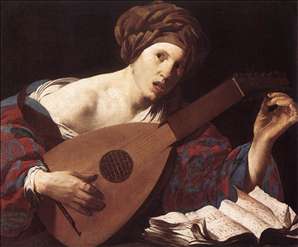
The concert




A Boy plays a recorder

YoungWomen Tuning a Lute and Singing


Duet

Boy lighting a pipe


Hendrick ter Brugghen, Flute Player (1621)
.jpg)
Hendrick ter Brugghen画的人物多是些酒鬼和音乐家, 看到他的一幅画:YoungWomen Tuning a Lute and Singing, 最近被Fitzwilliam Museum 以£443,020买下
Hendrick Jansz ter Brugghen (or Terbrugghen) (1588 – 1 November 1629) was a Dutch painter, and a leading member of the Dutch followers of Caravaggio — the so-called Dutch Caravaggisti
Biography
Little is known of the early life of ter Brugghen; he could have been born in The Hague, but his family seems to have moved to the strongly Catholic Utrecht in the early 1590s. Here he started painting at the age of thirteen, studying with Abraham Bloemaert. From Bloemaert, a Mannerist history painter, he learned the basics of the art. Around 1604, however, ter Brugghen travelled to Italy to expand his skills, a rather unusual move for Dutch painters at the time. He was in Rome in 1604, and could therefore have been in direct contact with Caravaggio (who fled the city in 1606 on a murder charge). He certainly studied his work, as well as that of his followers – the Italian Caravaggisti – such as Orazio Gentileschi. Caravaggio's work had caused quite a sensation in Italy. His paintings were characteristic for their bold chiaroscuro technique – the contrast produced by clear, bright surfaces alongside sombre, dark sections – but also for the social realism of the subjects, sometimes charming, sometimes shocking or downright vulgar. Other Italian painters who had an influence on ter Brugghen during his stay in Italy were Annibale Carracci, Domenichino and Guido Reni. ter Brugghen died in Utrecht in 1629.
Work and impact
Upon returning to Utrecht, he worked with Gerard van Honthorst, another of the Dutch Caravaggisti. Ter Brugghen's favourite subjects were half-length figures of drinkers or musicians, but he also produced larger-scale religious images and group portraits. He carried with him Caravaggio's influence, and his paintings have a strong dramatic use of light and shadow, as well as emotionally charged subjects. Even though he died young, his work was well received and had great influence on others. His treatment of religious subjects can be seen reflected in the work of Rembrandt, and elements of his style can also be found in the paintings of Frans Hals and Johannes Vermeer. Peter Paul Rubens described ter Brugghen's work as "...above that of all the other Utrecht artists."
主要作品;
The Adoration of the Magi (1619) — Rijksmuseum, Amsterdam
Flute Player (1621) — Gemäldegalerie, Kassel
The Calling of St Matthew (1621) — Central Museum, Utrecht
King David Playing the Harp — Warsaw National Museum, Warsaw
Doubting Thomas (c. 1621—1623) — Rijksmuseum, Amsterdam
The Bagpipe Player (1624) — National Gallery of Art, Washington
The Singing Lute-Player (1624) — National Gallery, London
The Annunciation (1624) — Whitfield Fine Art, London, London
Granida & Daifilo (1625) — Getty Museum, Los Angeles
Saint Sebastian Tended by Irene (1625) — Allen Memorial Art Museum, Oberlin
The Crucifixion with the Virgin and St John (c. 1625) — Metropolitan, New York
Bacchante & Ape (1626) — Getty Museum, Los Angeles
The Concert (1626) — National Gallery, London
Jacob Reproaching Laban (Bible) (1627) — National Gallery, London
Democritus (1628) — Rijksmuseum, Amsterdam
Heraclitus (1628) — Rijksmuseum, Amsterdam
Duet (1628) — Louvre, Paris
Esau Selling His Birthright (?) — Bob Jones Museum and Gallery, Greenville, SC











.jpg)